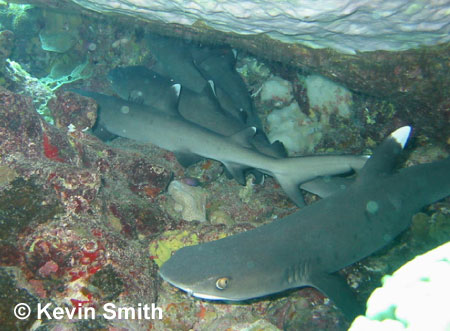Coral Reefs: Diversity on Display
Whitetip Reef Shark
Despite having a face that looks strangely like that of a disgruntled weasel, the Whitetip Reef Shark (Triaenodon obesus) is generally unaggressive toward humans who invade its environment. Although it often rests in caves during daylight hours, this species is probably the most commonly-encountered shark of the tropical Pacific. Indeed, for many divers and snorkellers, the phlegmatic Reef Whitetip is their only ambassador to sharkdom.
Just the Facts:
Size:
Reproduction:
Diet:
Habitat: Sandy Plains, Rocky Reefs, Coral Reefs, Deep Sea Depth: 3-1080 ft (1-330 m), often at 26-130 ft (8-40 m) Distribution: Central Pacific, South Pacific, Tropical Eastern Pacific, Southern African, Madagascaran, Arabian, Indian, South East Asian, Western Australian, Northern Australian, Japanese |
Despite its formal species name, obesus, the Whitetip Reef Shark is rather slender and delicately built. This body form grants it the ability to slither, eel-like into crevices in the reef, where this species is an absolute master at extracting prey. Quiescent during the day, Whitetip Reef Sharks become active and determined hunters at night. Moving over the reef face in loosely organized packs, these sharks systematically poke their blunt heads into each crack and crevice in the reef face in search of prey. Known prey of the Whitetip Reef Shark includes sleeping diurnal teleosts or hiding nocturnal creatures such as octopuses, soldierfishes, wrasses, and trumpetfishes, which are grasped with its small, tricuspid teeth. Using its ampullae of Lorenzini and uniquely tube-flapped nares, the Whitetip Reef detects its prey primarily by bioelectrical cues and scent. When a hunting Whitetip Reef locates a prey animal within a hole in the reef face, it violently twists and turns to push itself deep into the crevice. Some sharks actually squirm into a hole in one side of a coral head and exit through an opening on the other. During these zealous foraging bouts, Whitetip Reef Sharks have been observed breaking off pieces of coral — sometimes tearing their skin and fins. Although they are primarily nocturnal, Whitetip Reef Sharks can and do feed opportunistically by day.
In addition to electrical and olfactory cues, the Whitetip Reef Shark is also highly responsive to sounds and vibrations. In experiments conducted at the Marshall Islands and French Polynesia, Whitetip Reefs consistently responded to recorded sounds of struggling fish, feeding sharks, and even vocalizations of teleosts. At Eniwetok Atoll, Marshall Islands, artificially generated sounds were found to be most attractive to Whitetip Reef Sharks when they combined low frequency (25-100 Hertz) with varied intermittent pulses every 7.5 to 15 seconds. These sound characteristics correspond well to the irregular sounds and vibrations generated by a fish struggling on the end of a spear or on hook and line. In South Pacific areas where spearfishing is common, Whitetip Reef Sharks respond very rapidly to the sound of a speargun discharge, typically appearing within seconds. Although normally quite placid, this inquisitive species can become persistent and bold when faced with a diver playing or carrying a speared fish — sometimes dashing in to tear an impaled fish from the spear tip.
 Due to the abundance of Whitetip Reef Sharks in coastal areas of the
tropical Pacific and Indian Oceans, day-to-day life of this species is
better known than that of most sharks. Whitetip Reefs are most often
encountered during daylight hours while they rest quietly in underwater
caves throughout much of the tropical Indo-Pacific or in lava tubes of
Hawaiian reefs. But in some locations — such as at Cocos Island and
near-shore waters off the Pacific coast of Costa Rica — this species is
often seen lying stretched out on the sandy bottom, completely exposed in
broad daylight. Sometimes, several of these gregarious sharks are seen lying
side-by-side or even stacked on top of one another, like cord-wood. The
significance of these diurnal al fresco gatherings is not known, but may
have something to do with these sharks being cleaned by small wrasses and at
least one species of goby.
Due to the abundance of Whitetip Reef Sharks in coastal areas of the
tropical Pacific and Indian Oceans, day-to-day life of this species is
better known than that of most sharks. Whitetip Reefs are most often
encountered during daylight hours while they rest quietly in underwater
caves throughout much of the tropical Indo-Pacific or in lava tubes of
Hawaiian reefs. But in some locations — such as at Cocos Island and
near-shore waters off the Pacific coast of Costa Rica — this species is
often seen lying stretched out on the sandy bottom, completely exposed in
broad daylight. Sometimes, several of these gregarious sharks are seen lying
side-by-side or even stacked on top of one another, like cord-wood. The
significance of these diurnal al fresco gatherings is not known, but may
have something to do with these sharks being cleaned by small wrasses and at
least one species of goby.
Aspects of the private lives of consenting adult Whitetip Reef Sharks have been observed. On several occasions at Rangiroa Atoll, Marshall Islands, two to five mature male Whitetip Reefs were observed following a mature female, possibly attracted by a pheromone ‘perfume’ released by the female to announce her readiness to mate. Actual copulation in a pair of Whitetip Reef Sharks has been photographed in June 1982 at Molokini Crater, 2.5 miles (4 kilometres) southwest of the island of Maui, Hawaii. Mating took place on the bottom at a depth of 23 feet (7 metres). Both partners’ heads were pressed into the substrate of volcanic rubble and their bodies were aligned parallel to one another, extending upward into the water column at an angle of about 45 degrees. The female Whitetip Reef had fresh cuts above her gill slits and behind her first dorsal fin, presumably from her suitor’s precopulatory ‘love nips’. The smaller male shark had a tight grasp on the female’s left pectoral fin as his left clasper was flexed 90 degrees across his belly and inserted into her vent. The male Whitetip Reef had a swollen and distended left siphon sac — a subcutaneous organ in male sharks that stores the seawater used to flush sperm through the clasper groove and into the reproductive tract of females. After documenting this intimate moment, the underwater photographer and his diving companions opted to leave the mating sharks in peace.
Tagging and telemetry studies have revealed much about the home range and general ecology of the Reef Whitetip Shark. At Mahuta Reef in the Avatoru Lagoon area of Rangiroa Atoll, 75 Whitetip Reefs were tagged, of which 64 (85%) were resighted. Of these 64 individuals, only 8 (13%) were ever resighted beyond Mahuta Reef and of these 8 only 2 (25%) were sighted at other reefs. A year after tagging was completed, about 75% of Whitetip Reefs at Mahuta still bore tags or tagging scars. Even after 3.3 years, some 40% of the sharks had remained in the immediate. This strongly suggests that Whitetip Reef Shark populations are highly stable, with only a trickle of immigration and emigration each year. Telemetry studies of this species at Mahuta have demonstrated that typical day-time range is only 0.02 square miles (0.05 square kilometres) — about the area of Vatican City or about 10 American football fields. At night, however, the same sharks ranged over an area of about 0.4 square miles (1 square kilometre) — an area 20 times as large, or about 100 times the area of a union rugby field. These data suggest that the Whitetip Reef Shark is a definite ‘home-body’, rarely venturing far from a relatively small area.

The Reef Whitetip is one of the three most common sharks on Indo-Pacific coral reefs, the other two being the Blackfin Reef Shark (Carcharhinus melanopterus) and the Grey Reef Shark (Carcharhinus amblyrhynchos). Although these three sharks are widely distributed over the vast expanse of the tropical Pacific and Indian Oceans, their relative distribution over the reef profile is remarkably uniform from place to place. Blackfin Reef Sharks, especially juveniles, are typically found closest to shore, inhabiting the turbid lagoon shallows over sandy plains at depth from 0 to 50 feet (0 to 15 metres). Juvenile Grey Reef Sharks are found in the clearer, deeper waters of the back reef, while adults of this species typically patrol the reef crest and fore reef from the depth of about 65 feet (20 metres) down to a depth of about 330 feet (100 metres). Both species are most active at dawn and dusk, accomplishing most of their feeding during these twilight hours when schooling diurnal fishes are most vulnerable.
Neatly nestled between the crepuscular Blackfin Reef and Grey Reef sharks, Whitetip Reefs typically haunt the reef flats and shallower parts of the fore-reef at depths of 35 to 100 feet (10 to 30 metres). Although it can extend its range from the intertidal to at least 130 feet (40 metres), the Whitetip Reef manages to coexist with the Blackfin Reef and Grey Reef Shark by feeding primarily at night and specializing in extracting prey from cracks and crevices in the reef face that are all but inaccessible to these other sharks. By inhabiting different depths and ecological niches, the slender, weasel-faced Whitetip Reef Shark reduces competition for food resources with other sharks sharing its habitat.

